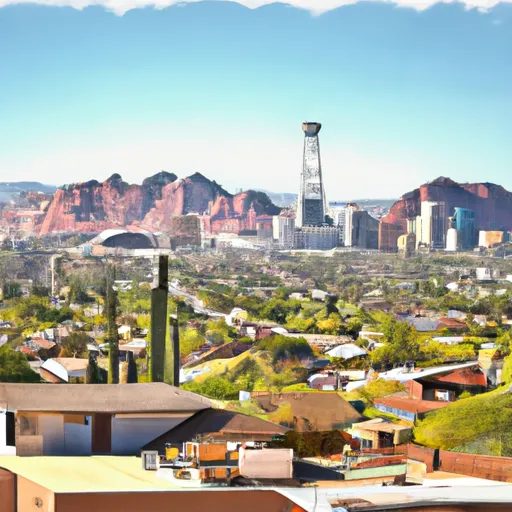-
 Snoflo Premium
Snoflo Premium
Get unlimited access to all our content
With no Ad interruptions! - Start Your Free Trial Login with existing account
Saint-Johns
Eden Index
Climate
8.8
•
Recreation
1.4
•
Community
•
Safeguard
4.0/10

Saint Johns is a small town located in Apache County, Arizona. It experiences a semi-arid climate, with hot summers and mild winters. Summers are characterized by high temperatures, often reaching the mid-90s Fahrenheit, while winters see average temperatures in the 40s to 50s. The area receives around 10 inches of rainfall annually, most of which occurs during the summer monsoon season.
The town is surrounded by several hydrological constituents, including the Little Colorado River and several small creeks. These water sources provide opportunities for fishing, kayaking, and other water-based activities. Additionally, there are several reservoirs nearby, such as Lyman Lake and Sunrise Lake, offering further recreational opportunities like boating and swimming.
Outdoor recreation enthusiasts can also enjoy hiking, camping, and exploring the nearby Apache-Sitgreaves National Forest. The forest is known for its diverse wildlife, scenic trails, and picturesque views, making it an ideal location for nature lovers.
Overall, Saint Johns, Arizona offers a semi-arid climate with hot summers and mild winters, several hydrological constituents for water-based activities, and ample opportunities for outdoor recreation in the nearby national forest.
What is the Eden Index?
The Snoflo Eden Index serves as a comprehensive rating system for regions, evaluating their desirability through a holistic assessment of climate health, outdoor recreation opportunities, and natural disaster risk, acknowledging the profound impact of these factors on livability and well-being.
Climate Health Indicator (CHI): 8.8
Saint-Johns receives approximately
255mm of rain per year,
with humidity levels near 50%
and air temperatures averaging around
13°C.
Saint-Johns has a plant hardyness factor of
6, meaning
plants and agriculture in this region thrive during a short period during spring and early summer. Most
plants will die off during the colder winter months.
By considering the ideal temperature range, reliable water supplies, clean air, and stable seasonal rain or snowpacks, the Climate Health Indicator (CHI) underscores the significance of a healthy climate as the foundation for quality living.
A healthy climate is paramount for ensuring a high quality of life and livability in a region, fostering both physical well-being and environmental harmony. This can be characterized by ideal temperatures, reliable access to water supplies, clean air, and consistent seasonal rain or snowpacks.
Weather Forecast
Streamflow Conditions
Little Colorado
Area Rivers
Little Colorado
Snowpack Depths
Little Colorado
Reservoir Storage Capacity
Little Colorado
Groundwater Levels
Recreational Opportunity Index (ROI): 1.4
The Recreational Opportunity Index (ROI) recognizes the value of outdoor recreational options, such as parks, hiking trails, camping sites, and fishing spots, while acknowledging that climate plays a pivotal role in ensuring the comfort and consistency of these experiences.
Access to outdoor recreational opportunities, encompassing activities such as parks, hiking, camping, and fishing, is crucial for overall well-being, and the climate plays a pivotal role in enabling and enhancing these experiences, ensuring that individuals can engage in nature-based activities comfortably and consistently.
Camping Areas
| Campground | Campsites | Reservations | Toilets | Showers | Elevation |
|---|---|---|---|---|---|
| Winn | 63 | 9,320 ft | |||
| Rolfe C. Hoyer | 91 | 8,320 ft | |||
| Sunrise Lake | 200 | 9,341 ft | |||
| Gabaldon | None | 9,402 ft | |||
| Benny Creek | 24 | 8,261 ft | |||
| Lyman Lake State Park | 61 | 5,994 ft |
Catastrophe Safeguard Index (CSI):
The Catastrophe Safeguard Index (CSI) recognizes that natural disaster risk, encompassing floods, fires, hurricanes, and tornadoes, can drastically affect safety and the overall appeal of an area.
The level of natural disaster risk in a region significantly affects safety and the overall livability, with climate change amplifying these risks by potentially increasing the frequency and intensity of events like floods, fires, hurricanes, and tornadoes, thereby posing substantial challenges to community resilience and well-being.
Community Resilience Indicator (CRI):
The Community Resilience Indicator (CRI) recognizes that education, healthcare, and socioeconomics are crucial to the well-being of a region. The CRI acknowledges the profound impact of these elements on residents' overall quality of life. By evaluating educational resources, healthcare accessibility, and economic inclusivity, the index captures the essential aspects that contribute to a thriving community, fostering resident satisfaction, equity, and social cohesion.

